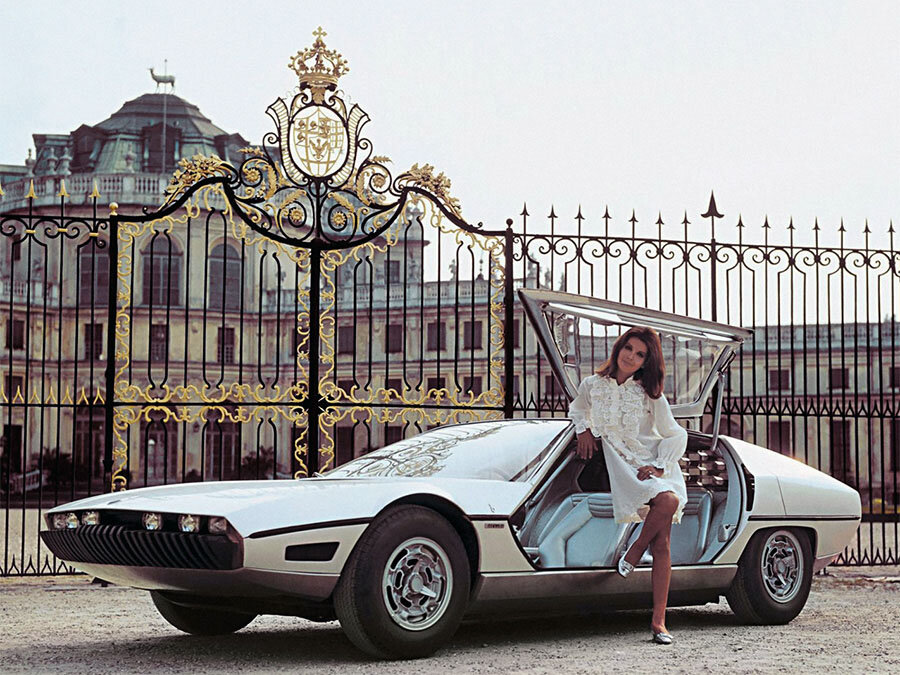Guide: New Age at 150mph - a Historical & Technical Appraisal of the Lamborghini Marzal
/BACKGROUND
One year after the Miura’s sensational debut, another revolutionary Lamborghini was unveiled.
The extraordinary new Marzal was a fully operational styling concept created to showcase how a four-seat Lamborghini might look.
Another collaboration between Lamborghini and Nuccio Bertone’s Turin design studio, the Marzal’s appearance dripped with science-fiction influences and shook the establishment to its core.
At the time, Ferrari had the four-seat GT market pretty well wrapped up. However, alongside the Marzal, Maranello’s second series Ferrari 330 GT looked positively antiquated.
Named after a strain of fighting bull, the Marzal was first displayed at the Geneva Motor Show in March 1967. If public reaction proved sufficiently positive, Lamborghini planned to develop a production version to sell alongside the existing Miura and 400 GT 2+2.
Such a line-up would mean, aside from a roadster, Lamborghini offered a direct rival to every one of Ferrari’s major models.
It was also hoped a full four-seater would sell in greater numbers than any other Lamborghini and bring the firm some much-needed financial stability.
CHASSIS
The Marzal was built on a heavily modified version of the Miura’s steel semi-monocoque chassis.
To increase cabin space, the wheelbase was extended by 120mm. However, at 2620mm, this was still fairly compact for a full four-seater.
Like the Miura, suspension was fully independent via double wishbones, coil springs, telescopic dampers and anti-roll bars.
Ventilated Girling disc brakes were fitted all round along with unique 6.5 x 14-inch Campagnolo cast magnesium wheels. These were held in place with a triple eared lock nut and shod with Pirelli Cinturato tyres.
A 75-litre fuel tank was located underneath the front lid. This area also provided considerable luggage capacity.
ENGINE / TRANSMISSION
The Marzal was powered by a prototype straight six engine built specially for this application.
A straight six was chosen as the car did not have enough space to accommodate four seats and a V12.
Lamborghini essentially took the rear bank of a Miura engine, rotated it 180° and mounted it transversely in the chassis at a 30° forward angle for better weight distribution.
To free up luggage space in the front, the radiator was also housed in the engine bay.
Lamborghini’s diminutive TP200 engine used in the Marzal was a dry-sumped, all-alloy, dual overhead camshaft unit that displaced 1964cc thanks to a bore and stroke of 82mm and 62mm respectively.
It ran a 9.2:1 compression ratio and three twin-choke Weber 40 DCOE sidedraught carburettors.
Peak output was 175bhp at 6800rpm and 132lb-ft at 4600rpm.
Transmission was via the standard Lamborghini five-speed gearbox (mounted transversely) and a single-plate clutch.
BODYWORK
After Bertone’s outstanding work on the Miura, they were the obvious choice to style this latest machine.
Lamborghini’s earliest models (the 350 GT and 400 GT) had been designed by Carrozzeria Touring, but when the Milanese firm went out of business in 1966, Lamborghini started an association with Bertone that lasted 25 years.
The Marzal’s other worldly look was created for Bertone by Marcello Gandini. Gandini emerged as head stylist at the firm once Giorgetto Giugiaro left to establish Ital Design.
Long, low and sleek, among the Marzal’s most startling feature was its enormous pair of Gullwing doors.
Owing to the car’s compact dimensions and fairly short wheelbase, Gandini elected to fit a single Gullwing door per side. Huge glass panels made up most of each door’s surface area, including the lower portion. Ferruccio Lamborghini was famously not a fan for privacy reasons.
When opened, the doors were supported by a pair of transverse rear springs.
Another enormous glass panel made up most of the roof area.
At the front, Gandini housed the six headlights and black rubber bumper within the nose aperture, a styling trick subsequently much copied.
A black rubbing strip formed a swage line down each flank.
Neatly concealed behind each door was an intake to feed fresh air to the engine and radiator.
The lower nose and tail panels along with the sills were finished in polished metal to lend the car a more slender profile.
Instead of a conventional rear windscreen, the one-piece engine cover (hinged at the trailing edge) received an in-vogue louvred panel made up of hexagonal aluminium slats that had been riveted together.
Aside from the enormous front hood, which was aluminium, the rest of the body panels were formed in steel.
INTERIOR
As with the exterior, Gandini gave the Marzal a highly futuristic interior.
The hexagonal honeycomb theme continued to the dash, centre console and even the seats which were trimmed in reflective silver upholstery to match the bodywork.
The gigantic glass area gave the Marzal a light and airy feel. However, the windows could not be lowered and the roof could not be opened which meant its specially developed air-conditioning system was essential.
WEIGHT / PERFORMANCE
The finished car weighed in at 1310kg and had an estimated top speed of around 140mph.
RECEPTION
Reaction to the Marzal was so overwhelmingly positive that Ferruccio Lamborghini immediately gave the go ahead for a slightly more conservative front-engined production version.
During the course of its ten year lifespan, the resultant Espada went on to become Lamborghini’s most commercially successful model yet.
After it was shown at Geneva, the Marzal was displayed at a number of other motor shows. It was also used by Prince Rainier III and Princess Grace for the parade lap that preceded the 1967 Monaco Grand Prix.
Text copyright: Supercar Nostalgia
Photo copyright: Bertone - https://www.bertone.it

































